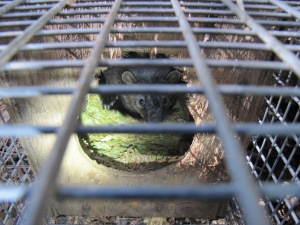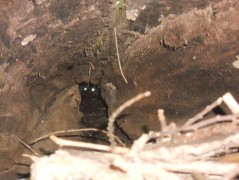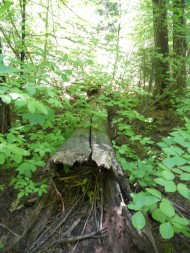When you wake up in the morning, you never really know what the day is going to have in store for you. We do, after all, carve out our niche in the world by following the daily habits of small furry critters in a predominantly wild landscape. We often grow attached to our fuzzy wards (how could we not?). So when something in our data collection portends trouble for one of them, we mobilize to see what we can do.
Males that we capture and deem healthy enough to carry the weight sport ARGOS collars. These collars communicate with orbiting satellites to determine the collar’s location and the satellites then relay location information via email right to my laptop.

There’s me in the corner!
Armchair biology. Technology! While this sounds like a road to obsolescence for field biologists, we still need to track the collar (and fisher) down when the data tells us something is amiss. The collars are only on during certain times each day, and during this window the collar transmits once a minute to the satellites. We’ve got a nifty receiver that lets us track it down via strength of the signal and distance from the collar as it transmits.
Male 190 was released in December 2011, and has been with us a little while. He’s often seen at female den trees during mating season, and all in all, he’s just a sturdy, well built fellow. It was distressing, therefore, to see some of the data from his collar suggest that he might no longer be with us. To figure out if 190 was ok Julie and I looked into when the collar transmits and, lucky for us (sarcasm), it transmits from 5PM – 9PM and again from 1AM-5AM. With the weather being wet as it has been for a time, we knew it was going to be an interesting hunt. Just what we enjoy, if you can believe it. We hoped for a dropped collar, and tried not to think about finding a carcass. It was wet, getting dark, and we were heading into uncertain terrain.
Andria volunteered to go out hunting with me. With the rain and the wet muddy roads, going in by truck was out of the question. Not to mention our only access was a long and partially closed road that would have required chainsaws, and more time (and daylight) than we could afford. So ATVs were on the menu. We knew the area we were headed to, and had a rough route planned (no one had visited this area since the rain, so all routes are tentative). After dropping the trucks and heading out on the ATVs we began hearing the signal we had hoped for. We continued on our pre-planned route, as a time or two doing this has taught me that signals broadcast up from a creek bottom can give misleading readings from a ridge top. Along the way we had to move downed trees and rocks.
After getting all the way down to where our most recent data suggested 190 may be, we could hear no signals from the collar. This had me daring to think that maybe, just maybe, he’s still alive – but somewhere other than where the recent points told us he might be. We rushed as best we could back to the top of the ridge and posted up for a few minutes. Lo and Behold, the signal boomed in to our receiver and continued to change in direction and intensity, quite quickly. He was not far from where we randomly stopped, doing his thing and probably oblivious to our racket!
Relief. Elation. High fives. Back to the truck. We were able to get out there, nose about, and determine that this guy is still hanging around, though probably weathering the worst of the rain in a tree hole somewhere, shielding the collar from reaching the satellites. A good nights work, and home before 10PM.
UPDATE 2/15/2014: Activity data from collar came through tonight and shows good readings across the board. Sweet.

























